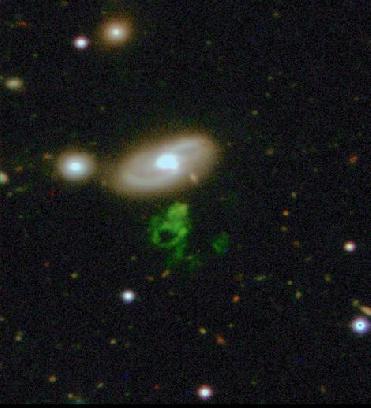
LONDON (BNS): A Dutch schoolteacher Hanny van Arkel has discovered a mysterious astronomical object through the Galaxy Zoo project, which enables members of the public to take part in astronomy research online. She came across the image of a strange gaseous object with a hole in the centre that has been described as a 'cosmic ghost' whilst using the www.galaxyzoo.org website to classify images of galaxies.
Scientists at the Hubble Space Telescope will soon take a look at the ‘cosmic ghost’, posted by van Arkel, which quickly became known as Hanny's 'Voorwerp' after the Dutch for 'object'.
Speaking about the discovery, Kevin Schawinski, a member and co-founder of the Galaxy Zoo team said what they saw was really a mystery. “The Voorwerp didn't contain any stars, but it was made entirely of gas so hot, about 10,000 Celsius, that the astronomers felt it had to be illuminated by something powerful,” Schawinski said.
Van Arkel was happy at her discovery and said that it was a fantastic gift to get on her 25th birthday. “It's amazing to think that this object has been sitting in the archives for decades and that amateur volunteers can help by spotting things like this online," she said.
Since there were no previous references of Voorwerp, the Schawinski team looked to find the source of illumination around the Voorwerp, and soon turned to IC2497, the nearby galaxy.
Explaining the closeness, the Yale astrophysicist said, "We think that in the recent past the galaxy IC 2497 hosted an enormously bright quasar because of the vast scale of the galaxy.” He said probably light from that past still lights up the nearby Voorwerp even though the quasar shut down some 100,000 years ago, with the galaxy's black hole going silent.
Co-organiser of Galaxy Zoo at Oxford University, UK, Chris Lintott said that from Voorwerp view, the galaxy looks as bright as it would have been before the black hole turned off. It's this light echo that has been frozen in time to observe, Lintott said. Comparing the likeness to a scene of crime, Lintott said, “we know the culprit must be lurking somewhere nearby in the shadows.” It is believed that similar light echoes have been seen around supernovae that exploded decades or centuries ago.
Equating Voorwerp with quasars, Israel Munson Professor of Physics & Astronomy and Chair of the Physics Department at Yale, C. Megan Urry said, “The strange 'Hanny's Voorwerp' looks like it could be the nearest example of a luminous quasar."
The Yale astro-physicist said, "IC 2497 is so close that if the quasar was still shining today, probably one could view it with a small telescope.” The nearest active quasar, called 3C 273, is 1.7 billion light years further away, he added.
"This discovery shows how citizen science has come of age in the Internet world," said Professor Bill Keel of University of Alabama, a galaxyzoo.org team member. “Hanny's attentiveness alerted us not only to a peculiar object, but to a window into the cosmic past which might have eluded us for a long time otherwise,” Keel said.
 Previous Article
Previous Article Next Article
Next Article











The Indian Air Force, in its flight trials evaluation report submitted before the Defence Ministry l..
view articleAn insight into the Medium Multi-Role Combat Aircraft competition...
view articleSky enthusiasts can now spot the International Space Station (ISS) commanded by Indian-American astr..
view article